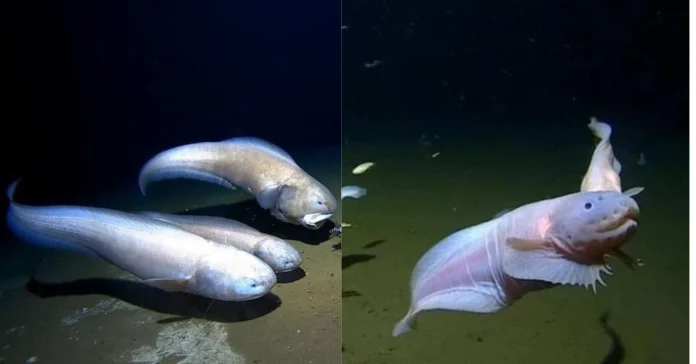Introduction
The ocean, a vast and mysterious world, is home to millions of species, each with its unique
adaptations and behaviors. One such creature that has captured the attention of marine biologists
and deep-sea enthusiasts is the Mariana snailfish (Pseudoliparis swirei). Found lurking in the
depths of the Mariana Trench, this peculiar fish offers a glimpse into a world largely unexplored
by humans. In this article, we will dive deep into the abyss to uncover the secrets of the Mariana
snailfish, exploring its habitat, behavior, adaptations, and research conducted on this fascinating
species.
An Uncharted World: The Mariana Trench
The Mariana Trench is in the western Pacific Ocean, is the deepest depths of the world's oceans.
At its deepest point, known as the Challenger Deep, it stretches down to an astounding 36,000
feet (10,972 meters). This dark and foreboding environment is cold and experiences intense
pressure, equivalent to 50 jumbo jets piled on top of a person. Despite these harsh conditions, life
perseveres, and one of the most enigmatic residents of this abyssal realm is the Mariana snailfish.
An Elusive Creature: The Mariana Snailfish
Discovered in 2014 and formally described in 2017, the Mariana snailfish is a small, gelatinous,
and tadpole-like creature with a length of up to 10 inches (25 centimeters). Its transparent, scale-
less skin and ghostly appearance are adaptations that have enabled it to survive in the crushing
depths of the Mariana Trench. Interestingly, the Mariana snailfish is the deepest-dwelling fish
species ever discovered, living at depths between 22,000 and 26,000 feet (6,700 and 8,000
meters).
Unique Adaptations for Survival
Living in the Mariana Trench's unforgiving depths requires many adaptations, and the Mariana
snailfish is no exception. One notable adaptation is its semi-transparent, scale-less skin, which
allows the fish to blend in with its dark surroundings, providing camouflage from predators.
Additionally, its gelatinous body is composed primarily of water, allowing it to withstand the
immense pressure found at these depths.
The Mariana snailfish's diet consists mainly of tiny crustaceans and other invertebrates that also
dwell in the abyss. The snailfish's specialized teeth and unhinging jaw are believed to enable it to
consume prey larger than its mouth. Furthermore, its robust digestive system, capable of
processing food in the nutrient-scarce environment, is yet another adaptation that has allowed
this fascinating fish to thrive in such an extreme habitat.
Studying the Mariana Snailfish: Research and
Discoveries
Given the challenges of exploring the Mariana Trench, studying the Mariana snailfish has been
no easy task. Researchers have employed various techniques, including baited traps and remotely
operated vehicles (ROVs), to observe and collect specimens for further study. These efforts have
resulted in many discoveries about the fish's biology and ecology, shedding light on how life can
persist in the most inhospitable corners of our planet.
The Importance of Pressure: A Key to the Snailfish's Success
The most exciting aspects of the Mariana snailfish is its ability to thrive under extreme pressure.
Studies have shown that the fish's cellular structure and biochemistry have adapted to these
conditions, allowing it to function properly at depths where other organisms would be crushed.
In particular, the Mariana snailfish's proteins and enzymes have evolved to remain stable and
functional under high pressure, a critical factor for its survival in the deep sea.
Reproduction in the Abyss
As with many aspects of the Mariana snailfish's life, its reproductive strategies remain somewhat
mysterious. While detailed information about its mating and spawning behaviors is scarce,
researchers have discovered that Mariana snailfish lay their eggs in gelatinous masses, which are
thought to protect them from predators and the harsh environment. Further research is required to
uncover the intricacies of the Mariana snailfish's reproductive habits and the factors influencing
its success in the deep sea.
Conservation and the Future of the Mariana Snailfish
Although the Mariana snailfish resides in an environment far removed from human activity, it is
not immune to the impacts of our actions. Climate change, ocean acidification, and pollution
pose potential threats to the Mariana Trench ecosystem and, by extension, the snailfish.
However, as more information about this elusive species becomes available, efforts to preserve
and protect its habitat and ensure its continued survival can be developed.
The Role of Citizen Science and Public Engagement
As the Mariana snailfish and its habitat become better understood, opportunities for citizen
scientists and the general public to engage in its conservation will emerge. From participating in
data collection and monitoring efforts to supporting policies and organizations that promote
ocean health, there are numerous ways individuals can make a difference in preserving this
unique and enigmatic species.
Conclusion
In this article, we have delved into the mysterious world of the Mariana snailfish, exploring its
incredible adaptations, behavior, and ongoing research to understand this remarkable deep-sea
dweller. As we continue to understand the secrets of the Mariana Trench, the Mariana snailfish
serves as a reminder of the resilience and diversity of life on our planet, even in the most extreme
and inhospitable environments. By learning about and engaging with the conservation efforts
surrounding this fascinating species, we can all play a part in protecting our planet's rich
biodiversity for future generations to appreciate and enjoy.

